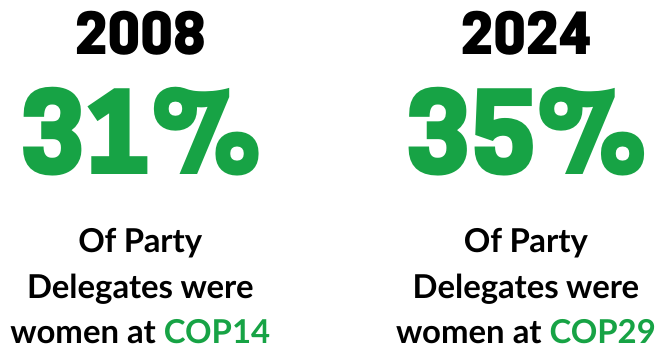Updated with new data from June 2025!
Since 2008, WEDO has tracked data to understand trends in women's participation at the major negotiating meetings of the United Nations Framework Convention on Climate Change (UNFCC). Over the years, there has been progress on women and gender diverse people's inclusion in the process, both in overall participation as Party delegates and at the highest levels of decision-making, though this progress is inconsistent and uneven.
The most well-known UNFCCC negotiating meeting is the Conference of the Parties (COP), which is the primary decision-making body of the UNFCCC. All states that are Parties to the UNFCCC are represented at COP, where they review and direct the implementation of global climate goals. In 2008, the first year that the GCT collected this data, at COP14 in Poznań 31% of delegates were women, and 82% of Party delegations had more men than women. At COP29 in 2024, very few Party delegations had equal numbers of men and women, while the majority of delegations remained dominated by men: 35% of Party delegates were women, a less than 5 percentage point improvement since 2008, and 71% of Party delegations still had more men than women.

Progress in the intersessional negotiations, which are smaller, more technical meetings held between each COP to advance decisions, has been greater, particularly in recent years. At the June 2025 intersessional meeting in Bonn, 49% of Party delegates were women, whereas 33% of total delegates were women at the multiple intersessional meetings held in 2008. With the inclusion of a nonbinary option in UNFCCC registration processes, publicly available data on gender participation can go beyond the binary. At the recent intersessional in June 2025, with the inclusion of nonbinary participants, women and gender diverse people were 50% of all delegates.
Women and gender diverse people's access to and influence in UNFCCC negotiations still have some way to go before reflecting a truly gender-balanced process. Women and gender diverse people remain widely underrepresented on the delegations of many countries, particularly in high-level positions, as well as on the delegations of countries most vulnerable to climate impacts. Certain countries, regions, and negotiating blocs are more marked than others by these tendencies.
To learn more, explore trends in women's participation in Party delegations here.
Relevant Sources
WEDO (2012). Women’s Participation in UN Climate Negotiations, 2008-2012
WEDO (2014). Ensuring Women’s Access and Influence on Climate Change Policy, 2008-2014
WEDO (2022). Women's Participation in the UNFCCC: 2022 Report
WEDO (2023). Who Decides: Women's Participation in the UNFCCC





